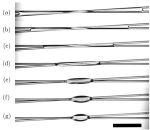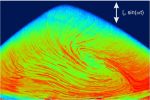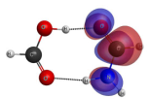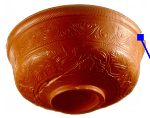News
EPJ B Highlight - Structural shift elucidated with large-scale atomic simulations
- Details
- Published on 30 June 2015

Iron-Nickel alloys’ structure changes as they heat up and cool down
Iron-nickel alloys are ubiquitous: they are found at the earth’s core and in meteorites. What is fascinating about such alloys is that their inner structure can change with rapid temperature swings. Heated up above 730 °C (1,340 °F), these alloys enter what is referred to as an austenitic phase. Alternatively, they can be turned into very hard alloys, referred to as a martensitic phase, by subjecting them to extremely rapid cooling. Now a team of scientists from Germany has, for the first time, created a large-scale simulation involving 275,000 atoms representing iron-nickel alloys in proportions found in nature. They show that transitions from one alloy structure to the other occurs in both an orderly and a disorderly way, depending on whether it is heated up or cooled down, respectively. These findings have been published in EPJ B by Emilia Sak-Saracino and Herbert Urbassek from the Research Center OPTIMAS at the University of Kaiserslautern, in Germany.
EPJ E Highlight - Improving insulation materials, down to wetting crossed fibres
- Details
- Published on 30 June 2015

Scientists model the manner in which a liquid wets fibres, gaining useful insights for improving glass wool properties
Sandcastles are a prime example of how adding a small amount of liquid to a granular material changes its characteristics. But understanding the effect of a liquid wetting randomly oriented fibres in a fibrous medium remains a mystery. Relevant to the building industry, which uses glass wool, for instance, this phenomenon can be better understood by studying the behaviour of a liquid trapped between two parallel fibres. It can either remain in the shape of a drop or spread between the fibres into a long and thin column of liquid. Now, scientists have demonstrated that the spreading of the liquid is controlled by three key parameters: the amount of liquid on the fibres, the fibres’ orientation and the minimum distance between them. These findings, based on experimental and modelling work, were recently published in EPJ E. The authors are Alban Sauret, a scientist working at a laboratory jointly operated by the CNRS and Saint-Gobain, a building materials manufacturer in France, and international colleagues based at Princeton University and the NYU School of Engineering, USA.
EPJ E Colloquium - The role of acoustic streaming in vertically vibrated granular beds
- Details
- Published on 30 June 2015

A recent EPJ E Colloquium by Jose Manuel Valverde looks at the fundamental physics that causes convection and fluidization in vibrated beds of particles with large inertia. The author examines the question of whether acoustic streaming arising from oscillatory viscous flows might play a role on the onset of convection and fluidization in vertically vibrated granular beds.
Acoustic streaming, first observed by Faraday in 1831, is an enigmatic phenomenon that has puzzled physicists for a long time. It occurs when a viscous fluid oscillates in the presence of a solid boundary. The dissipation of energy by viscous friction leads to a secondary steady circulation of fluid in a boundary layer near the surface of the solid, which enhances the gas-solid viscous interaction. Granular beds display, at sufficiently high vibrational intensities, surface patterns that bear a stunning resemblance to the surface ripples (Faraday waves) observed for low viscosity liquids. This suggests that the granular bed transits to a liquid-like regime, despite the large inertia of the particles.
EPJ D Highlight - Clues to inner atomic life from subtle light-emission shifts
- Details
- Published on 29 June 2015

Hyperfine structure of light absorption by short-lived cadmium atom isotopes reveals characteristics of the nucleus that matter for high precision detection methods
Atoms absorb and emit light of various wavelengths. Physicists have long known that there are some tiny changes, or shifts, in the light that gets absorbed or emitted, due to the properties of the atomic nucleus. Now, a team of scientists has elucidated the so-called hyperfine structure of cadmium atoms. Relying on a method called laser spectroscopy, they have measured variations in the energy transition within cadmium atom - Cd in the periodic table. They studied a chain of isotopes with an odd number of neutrons ranging from 59 in 107Cd to 75 in 123Cd. From these high-precision measurements, they were able to identify the physical cause of the shift within the nucleus. These findings by Nadja Frömmgen from the Johannes Gutenberg University Mainz, in Germany, and international colleagues have now been published in EPJ D.
EPJB Colloquium: From seconds to months: the multi-scale dynamics of mobile telephone calls
- Details
- Published on 24 June 2015

'Big Data' from electronic records derived from mobile telephone calls enables the study human behaviour and sociality in a quantitative way and with unprecedented statistical power. Cell phones are ubiquitous and Call Detail Records (CDRs), automatically collected by telecom operators are records of verified, time-stamped one-to-one communication. They are particularly useful to understand one-to-one communication patterns, as well as the dynamics of the social networks that are reflected in such patterns. In this EPJ B Colloquium, Jari Saramäki and Esteban Moro present an overview of empirical results pertaining to the multi-scale nature of social dynamics and networks, as inferred from CDRs.
EPJ issues findings from working group on peer review
- Details
- Published on 24 June 2015
On 15 June 2015 EDP Sciences (Paris, France) have released information on the findings and recommendations of a working group into the peer review process. The meeting involved a committee of experts linked to the European Physical Journal (EPJ) including Editors-in-Chief, Associate-Editors, members of the Steering Committee and researchers involved in Scientific and Technical Information. EPJ itself, represents 25 European Physical Societies through its Scientific Advisory Committee.
EPJ D Colloquium - Recent advances in the application of the Schwinger multichannel method with pseudopotentials to electron-molecule collisions
- Details
- Published on 18 June 2015

A new Colloquium paper published in EPJ D describes recent advances in the use of the Schwinger multichannel method and considers potential future applications of the technique. Based on the Schwinger variational principle for the scattering amplitude, the Schwinger multichannel method was designed to account for exchange, polarization and electronically multichannel coupling effects in the low-energy region of electron scattering from molecules with arbitrary geometry.
EPJ B Colloquium: Large scale simulations on GPU clusters
- Details
- Published on 15 June 2015

Graphics Processing Units (GPU) are currently used as a cost-effective platform for computer simulations and big-data processing. Large scale applications require that multiple GPUs work together, but the efficiency obtained with cluster of GPUs is, at times, suboptimal because the GPU features are not exploited at their best.
EPJ B Colloquium: Ceramics in art and archeology
- Details
- Published on 26 May 2015

Analytical techniques, originally developed for traditional materials, turn out to be very useful to study the composition and structure of artistic and historical specimens. But the reverse is also true. The study of ancient artefacts is providing interesting insights of more general interest to materials scientists, as well as inspiration for current artists.
EPJ E Highlight - How supercooled water is prevented from turning into ice
- Details
- Published on 20 May 2015

Calculating the energy barrier that keeps liquid water below zero from immediately turning into ice provides the key to understanding its ability to be compressed as temperature drops
Water behaves in mysterious ways. Especially below zero, where it is dubbed supercooled water, before it turns into ice. Physicists have recently observed the spontaneous first steps of the ice formation process, as tiny crystal clusters as small as 15 molecules start to exhibit the recognisable structural pattern of crystalline ice. This is part of a new study, which shows that liquid water does not become completely unstable as it becomes supercooled, prior to turning into ice crystals. The team reached this conclusion by proving that an energy barrier for crystal formation exists throughout the region in which supercooled water’s compressibility continues to rise. Previous work argued that this barrier vanished as the liquid gets colder. These findings have been published in EPJ E by Connor Buhariwalla from St. Francis Xavier University in Antigonish, Canada and colleagues.




